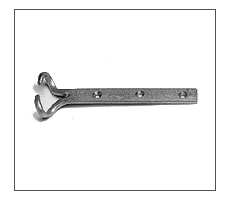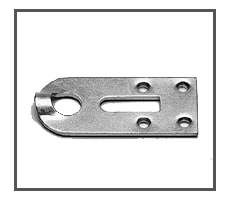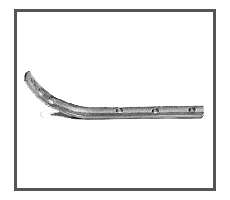You are using an out of date browser. It may not display this or other websites correctly.
You should upgrade or use an alternative browser.
You should upgrade or use an alternative browser.
What are these products and what do they do? (Stage brace)
- Thread starterThefoxygranpa
- Start date
skienblack
Active Member
Those are stage braces. They were used way back when to brace up flats. One side of the brace has these odd teach looking thing that would hook into the flat and the other side either has a plate mounted that can be sand bagged (as yours are) or has a metal bracket with a hole that a stage screw can be driven into. They usually telliscoped to make storage easier and allow them to hold up a variety of flats.
These fit into a section of scenery hardware that no one uses anymore. Back in "the day" there was an entire system used that would help get a box set up with broadway flats quickly and easily. This included lash cleats and eyes that you would use to "lace" flats together. Along with that was the wonderful stage screw. I have a small collection of stage braces of different vintages along with stage screws. They make great office decorations.
Today stage braces have been replaced with flat jacks. Along with that, very few places use soft covered flats for box sets. If you are going to ground support a box set these days, its built out of hollywood flats.
Don't get rid of them, they are a piece of stagecraft history!
These fit into a section of scenery hardware that no one uses anymore. Back in "the day" there was an entire system used that would help get a box set up with broadway flats quickly and easily. This included lash cleats and eyes that you would use to "lace" flats together. Along with that was the wonderful stage screw. I have a small collection of stage braces of different vintages along with stage screws. They make great office decorations.
Today stage braces have been replaced with flat jacks. Along with that, very few places use soft covered flats for box sets. If you are going to ground support a box set these days, its built out of hollywood flats.
Don't get rid of them, they are a piece of stagecraft history!
waynehoskins
Active Member
Looks kinda like an old stage brace, before they went metal. I haven't seen them quite like that, but it looks like it would make sense.
... and Kyle beat me to it, barely.
The ones I've seen are the stage-screw kind. These of course predate the Improved Stage Screw, which oddly I've never seen anyone use. Then again, I'm from the Hollywood era of flattage, so we primarily used jacks.
... and Kyle beat me to it, barely.
The ones I've seen are the stage-screw kind. These of course predate the Improved Stage Screw, which oddly I've never seen anyone use. Then again, I'm from the Hollywood era of flattage, so we primarily used jacks.
Last edited:
That is a lining stick or lining board
Last edited:
Thefoxygranpa
Active Member
Thanks for the quick replies everyone! I thought they were a brace for flats just wanted to make sure! These are the telescoping kind and the bottom piece of ply swivels. Where would you hook the stange thing at the top of these to on a flat?
I believe they have two dozen of these, and have no use really for them because they build hollywood flats and have other methods to hold them up now.
But I'm wondering if I can take a few off their hands to decorate the office
I believe they have two dozen of these, and have no use really for them because they build hollywood flats and have other methods to hold them up now.
But I'm wondering if I can take a few off their hands to decorate the office
The top funny looking double hook thingy

hooks onto a Stage Brace Cleat

Yours would appearto have a sand bag base plate. The other style of bottom end hard ware is this:

Which is called a "Rocker Heel" or "Screw Foot".
I found all these images on Rosco's webpage. They are all still being manufactured. Honestly a proper application of stage braces is just as effective as using "Modern" jacks.
Stage Braces such as the ones depicted here were very effective when flying large scenic peices. Thier entire construction is designed for quick and easy installation and interchangability, thus the rocker heels curve to accomadate a wide variety of hook up angles.
**** All images appearing here courtesy of Rosco

hooks onto a Stage Brace Cleat

Yours would appearto have a sand bag base plate. The other style of bottom end hard ware is this:

Which is called a "Rocker Heel" or "Screw Foot".
I found all these images on Rosco's webpage. They are all still being manufactured. Honestly a proper application of stage braces is just as effective as using "Modern" jacks.
Stage Braces such as the ones depicted here were very effective when flying large scenic peices. Thier entire construction is designed for quick and easy installation and interchangability, thus the rocker heels curve to accomadate a wide variety of hook up angles.
**** All images appearing here courtesy of Rosco
Last edited:
Thefoxygranpa
Active Member
Oh thanks for that Van! It looks like these may have more use than I thought. I'll look into getting some cleats for these as they all still have the double hook mechanism.
Oh and for the un-initiated. The cleat would normally install on the framing of a broadway flat with the rounded end with the hole pointing towards the center. This makes it so the "dented" part of the hole is towards the back of the flat. The Hook is attached by rotaing the brace so the opening in the hook is faced towards the flat you "catch" the raised dent with the hook then spin the brace around, this will bring the rocker foot back around to where it's usable.
It sounds a lot more confusing than it is. And it's sometimes hard to figure out the first time but once you do it it's easy.
It sounds a lot more confusing than it is. And it's sometimes hard to figure out the first time but once you do it it's easy.
kicknargel
Well-Known Member
At least a few years ago when I still worked for an opera we still used these. We still did the occasional muslin broadway flat as well, for flats that were large and needed to be gripped on for an intermission scene change--hollywoods would have been too heavy. We did big operas in a space with small wings and the set had to come apart pretty far for changes.
Nick Kargel
www.YouWantWhatProductions.com
Nick Kargel
www.YouWantWhatProductions.com
Tex
Active Member
Well now that you mention the stage screw, I have to do the joke!Along with that was the wonderful stage screw. I have a small collection of stage braces of different vintages along with stage screws. They make great office decorations.
What's the difference between a stage kiss and a stage screw?
About 15 minutes...
Well now that you mention the stage screw, I have to do the joke!
What's the difference between a stage kiss and a stage screw?
About 15 minutes...
Never heard that one before and don't understand it. Got my 1926 oak 16' stage brace from a theater that had a stock of 18" thru like 20' ones. Used it over the years from pulling gel between scenes to pulling tape off my peg wall for it. Never used it for its purpose but its an antique and I do love it as a concept for what it did. Should I still do scenery it would still have a purpose for me if quick change for the upper support a jack didn't fill the need for most often.
Kind of like a fire hook back stage overall, don't get rid of them even if not as much needed these days. Could be years but still useful. At least every fourth month I do pull such a thing out for a useful pushing, grabbing or pulling application - very useful tool to have about. And for theater such tools are still useful especially for support of taller flats where a stage jack won't support as well short of more material should it be needed.
Found in the past you don't persay need to screw jack into the floor to suppot such a thing, say a plate of soft rubber under a stage weighted plywood floor plate such a jack is screwed into. With weight the jack won't move and you don't need to screw into the floor in a similar way to if you add stage weight and soft rubber to a stage jack, you also don't need to screw it to the floor.
Makes damage to the deck and tie for removal less no matter which system used.
Last edited:
If storage of the "rocker heel" variety is a problem:
Take a 2x4 x (number of stage braces x 3") long. Pound 12d finish nails or drive 3" screws into the 1.5" edge on 3" centers, leaving 1.5"-2" sticking out. Draw a line on the face corresponding to the location of each nail. Affix the 2x4 to a blank out-of-the-way wall about 10' up, nails on top. Hang your braces upside-down, hooking the hole in the heel over the nail. (The line on the face shows you where the nail is.)
Keeps them off the floor, out of corners, and protects them from damage. Those afflicted with OCD will want to organize them by length from left-to-right or right-to-left.

Peachy Productions
Take a 2x4 x (number of stage braces x 3") long. Pound 12d finish nails or drive 3" screws into the 1.5" edge on 3" centers, leaving 1.5"-2" sticking out. Draw a line on the face corresponding to the location of each nail. Affix the 2x4 to a blank out-of-the-way wall about 10' up, nails on top. Hang your braces upside-down, hooking the hole in the heel over the nail. (The line on the face shows you where the nail is.)
Keeps them off the floor, out of corners, and protects them from damage. Those afflicted with OCD will want to organize them by length from left-to-right or right-to-left.

Peachy Productions
kicknargel
Well-Known Member
Huh. I though I'd be able to point you straight to BMI Supply, but that stuff is so out of fashion, it seems even they have dropped it from the catalog. You might call them or other older, established theatrical supplies. Maybe they'll have some lying around, or know who does.
Would it be crazy to want to use some of these for an upcoming show?
If you want to use them simply for the sake of doing so and not for proper function, yes somewhat. If you use broadway flats and already have lashing and bracing equipment that is in working order, and have the ability to do an entire production using the old ways of the force (in a show that would benefit from it), then it would be a great interactive history lesson. It'll take a few extra days to get the motions down well enough, and a long time to master (but hey, what doesn't?).
Similar threads
- Replies
- 2
- Views
- 2K
- Replies
- 16
- Views
- 2K
- Replies
- 2
- Views
- 1K
Users who are viewing this thread
Total: 1 (members: 0, guests: 1)




